How Solar Influences Utah’s 2019 Environmental Progress

Utah Valley pollution continually increases. This, however, doesn’t need to be the case. Utah is starting to make some environmental changes and you can too, with the help of residential solar power.
Utah Climate Change and Solar
Utah has been warming up, which means the hot dry summer months are even more barren than they have been in previous decades.
This year’s snowpack is looking good, but it is a delicate balancing act. If Utah gets too much water this spring, it could melt the snow too soon and cause flooding in the valley.
Climate change, however, is affecting more than just our weather conditions. It is also increasing health issues. If we continue on as if nothing is wrong, it will get past the point of no return.
Climate Change and Public Health in Utah
The quality of Utah’s air has a direct impact on the health of the public. In fact, it has been found that the pollutants that affect the health of Utah residents the most are particulate matter and ground-level ozone.
Combating Ground Level Ozone in Utah
Ozone is formed when volatile organic compounds (VOCs) and nitrogen oxides (NOx) react in the presence of sunlight. This is why an increase in ground-level ozone is a problem during the summer months.
Biogenics, emission from vegetation and soil, is the largest VOC. While emissions from our different modes of transportation are the largest contributor to NOx.
We can decrease the amount of ground-level ozone by increasing our use of electric vehicles or public transportation, turning our cars off instead of idling and filling up our tanks in the evening when it is cooler outside. If you want to increase your impact, even more, you can pair residential solar with an electric vehicle. When you do this, you are ensuring that the electricity charging your car is coming from a clean source instead of fossil fuels.
Decreasing Utah’s Particulate Matter With Solar
Particulate matter (PM) are minute grains in the air that are smaller than a human hair. When we breathe these particles they can cause lung issues. The main causes of particulate matter are secondary pollution sources such as nitrogen dioxide and sulfur dioxide in the atmosphere. However, in the Utah Valley, dust, fires and fuel combustion also play a large rule.
Utahans are encouraged to spend time doing less strenuous outdoor activities when PM levels are high. This, however, doesn’t reduce the PM levels.
Those who want to help reduce the cause of PM can help with the installation of a residential solar array. When you install solar on your home you are reducing the amount of fossil fuel needed to power your lifestyle. This in turn decreases the amount of harmful atmospheric pollution in your area.
As a result of air pollutants, there’s been an increase in respiratory and lung diseases. Despite the recent public and government infrastructure redesign of Salt Lake City as a major metropole, common modes of energy production and transportation have worsened the problem.
Utah’s Environmental Progress Statistics
As of 2016, a total of 27.5 million metric tons of carbon dioxide was produced by the electric sector in Utah. Another 17.7 million metric tons came from the transportation sector. Together these came to 76 percent of energy-related carbon dioxide emissions in the state.
Emissions are decreasing, but not as fast as the environment needs. In January of 2019, Utah generated 2,642 megawatt-hours of coal-fired electricity. And another 816 thousand megawatt-hours of electricity was from fired natural gas.
The large production of fossil fuels makes the 323 thousand megawatts of clean energy seam minuscule. To avoid contributing to this and help a better cause, it is worth looking into solar power as a Utah homeowner.
Utah’s Climate Change Forecast
Utah has recently implemented some environmental goals designed to change the climate outcome. With the help of these policies and concerned citizens, these policies will prove helpful.
Utah Climate Goals for 2019
In January of 2019, the Utah Air Quality Board voted on a pollution control plan. The state’s plan targets industries that release over 70 tons of fine particulate matter pollution. Although a great start, some feel it isn’t enough. To have a greater impact, these policies need to be amended to account for homeowners, incentivizing renewable forms of energy.
Some legislators have recommended bills that incentivize the use of cleaner cars. Others support incentives that decrease home emissions from high energy appliances and tools.
Regardless of which clean energy bills are put in place, citizens are becoming more aware of the problem and are taking a stand. In 2018, the percentage of solar generation in Utah was only out-performed by three states. According to Rocky Mountain’s Spokesman Spencer Hall, increased solar in Utah is due to both price and customer demand.
Utah Climate Change Predictions
Climate change is already impacting the world in which we live. And although this is making a difference, the collective action of concerned individuals is necessary.
How You can Contribute to the Cause With Solar
The best renewable source of energy for the average homeowner, all things considered, is solar. This is because it gives homeowners control over their energy production and consumption.
Solar not only helps the planet, but it fattens your wallet. The ROI of residential solar is quite substantial.
Another way you can increase your environmental impact is through the addition of solar backup. Solar panels on their own don’t store energy. Because of this, most people still rely on utility power, fossil fuels, at night and during massive storms.
Backup allows you to store your solar energy for later use. meaning you won’t have to use as much or any power from the grid. Go Solar Group has a variety of backup and battery options available for all solar needs.



Send a Message
Oops! We could not locate your form.